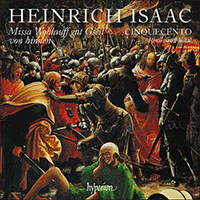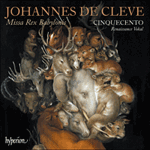Heinrich Isaac
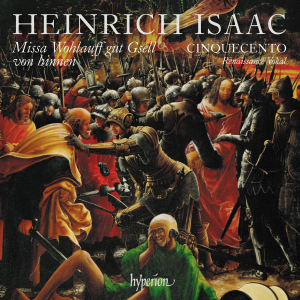
Composers: Heinrich Isaak
Released: 2021
Label: Hyperion, Hyperion records
Code: CDA68337
Description
Welcome to Hyperion Records, an independent British classical label devoted to presenting high-quality recordings of music of all styles and from all periods from the twelfth century to the twenty-first.
Hyperion offers both CDs, and downloads in a number of formats. The site is also available in several languages.
Please use the dropdown buttons to set your preferred options, or use the checkbox to accept the defaults.
 English
EnglishCDA68337
Heinrich Isaac (c1450-1517)
Missa Wohlauff gut Gsell von hinnen & other works
Cinquecento 

|
|
|||||||
|
|
|||||||
|
|
|||||||
|
|
|||||||
|
|
|||||||
|
|
|||||||
|
|
|||||||
|
|
|||||||
|
|
|||||||
|
|
|||||||
|
|
|||||||
|
|
|||||||
|
|
|||||||
|
|
|||||||
|
|
|||||||
|
|
|||||||
|
|
|||||||
|
|
|||||||
|
|
|||||||
|
|
|||||||
|
|
|||||||
|
|
|||||||
|
O decus ecclesiae[12’13]
|
|||||||
|
|
|||||||
|
|
|||||||
|
Judaea et Jerusalem[6’48]
|
|||||||
|
|
|||||||
|
|
|||||||
|
|
A talent eagerly sought by Lorenzo de’ Medici in Florence and later by Maximilian I in Vienna, Heinrich Isaac enjoyed a distinguished reputation during his lifetime. Listening to these idiomatic accounts from Cinquecento, it’s easy to understand why.
Awards
Reviews
Other recommended albums
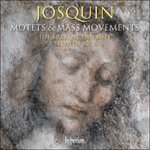
Josquin: Motets & Mass movements
CDA68321 Early Choral albums for £8.00Studio Master FLAC & ALAC downloads available
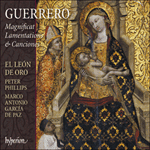
Guerrero: Magnificat, Lamentations & Canciones
CDA68347Studio Master FLAC & ALAC downloads available
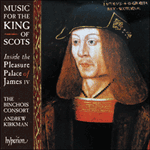
CDA68333Studio Master FLAC & ALAC downloads available
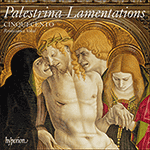
CDA68284 Early Choral albums for £8.00Studio Master FLAC & ALAC downloads available
For fifteenth-century artists, few cities were more magnetic than Florence: styling itself as a ‘new Athens’, its unparalleled intellectual and cultural climate drew philosophers, architects, painters—and musicians—from across Europe. Small wonder then that the aspiring singer-composer Heinrich Isaac took the opportunity to begin his professional career there in the 1480s. If the stories are true, Florence’s de facto ruler Lorenzo de’ Medici actively recruited him, luring him from his native Flanders with the promise of financial rewards, good working conditions, stimulating colleagues, and access to the highest social and political circles. The result was mutually beneficial: Isaac gained an international foothold, and Florence acquired an exceptional musical talent to perpetuate its reputation as a beacon of civilization.
In Florence, Isaac was one of the ‘Singers of San Giovanni’, who sang at services at the city’s principal religious institutions. Despite an official church appointment, however, Isaac’s activities extended well beyond the purely liturgical. The Medici used the Singers of San Giovanni for their private musical needs as well as for civic representation, and Isaac’s output proves that he was involved in both of these.
O decus ecclesiae combines various components of this nexus. Conceived on an extraordinary scale, the piece shows Isaac at his grandest. It draws its structure from one of Renaissance music’s basic building blocks: the six-note scale fragment known as the natural hexachord (the notes C, D, E, F, G and A). In each of the motet’s two sections, the tenor part systematically assembles and dismantles the hexachord one note at a time, beginning with its lowest pitch. A pedagogical aim cannot be ruled out, though a symbolic one seems more likely. Four additional voices surround this scaffold with a text that praises the Virgin Mary with classicizing imagery, reflecting the world of Renaissance Florentine humanism.
Lorenzo seems to have held Isaac in genuine affection. He smoothed the composer’s integration into Florentine society, while Isaac in turn set his patron’s poetry to music, and may have taught his children music. When Lorenzo died in 1492, the composer memorialized his patron in several works, including Quis dabit pacem populo timenti?. This motet draws on Classical precedent, borrowing lines from a funerary chorus from (Pseudo-)Seneca’s tragedy Hercules Oetaeus. Seneca’s words are supplemented with additional text that explicitly mentions Lorenzo and the Medici. The work is freely composed, without any pre-existent material. Its structure is articulated, rather, through the quantitative poetry of both Seneca and the additions: cadences, changes in vocal scoring, and rests in all voices render the lines and half-lines immediately audible, while the musical motifs often derive their rhythms directly from the longs and shorts of the words in a manner that would gain currency in the German metrical ode tradition of the following century.
Following Lorenzo’s death, Florence’s Golden Age came to an abrupt end. His weak son and heir Piero lost power and was sent into exile in 1494. The Dominican monk Girolamo Savonarola took over and instituted a strict and ascetic religious law under which complex music of the kind that Isaac produced was forbidden. Fortunately, a musician of Isaac’s stature was a desirable commodity elsewhere: by the end of 1496, he had gained a new position as court composer to the Habsburg Emperor Maximilian I, and he moved for a time to Vienna and Innsbruck. For Maximilian, Isaac was a prestigious import. His appointment offered a chance to put the imperial court chapel on the musical map. For Isaac, Maximilian offered unusually flexible working conditions that allowed him—once the worst of the troubles had passed—to reside in Florence, and to serve the emperor from a distance.
Although Isaac worked at the imperial court in spheres as diverse as those in which he had been active in Florence, his primary task was to provide the court chapel with a comprehensive liturgical repertory. Much of this consisted of new Mass settings and music for the Mass Proper based on Gregorian chant. But other compositional types were involved too, and at some point relatively early in his imperial tenure, Isaac turned to an earlier Mass that he had written in Florence, based on the popular song Comment peult avoir joye?. He may have known the song in monophonic form, and he certainly knew a polyphonic version that his contemporary and rival Josquin des Prez had composed in c1490, probably in Rome. The song’s text expresses a complaint against misfortune typical of its genre, replete with pastoral and natural analogies, and a self-referential observation on music’s (lack of) curative powers. Josquin’s setting treats the song in strict canon at the octave between the cantus and tenor voices. Song-derived material permeates the other two voices as well, creating a homogeneity among the parts that allows the structuring canon to remain hidden in the texture.
Although Comment peult was probably originally French, it was known also in Germany, but with a different text: Wohlauff gut Gsell von hinnen. Such re-texting—so-called ‘contrafactum’—was a common re-purposing method in the fifteenth and sixteenth centuries. Perhaps it was his discovery that Comment peult was known in German lands in a local version that inspired Isaac to adapt his Florentine Missa Comment peult. The earlier Mass was probably composed around 1490, and is a relatively typical four-voice work. The Comment peult melody is prominent throughout, often in the uppermost voice, and a number of reduced-voice sections treat it lyrically enough to have led some commentators to suggest that they are actually re-purposed song settings that predate the Mass. There are no overarching structuring devices, but several sections employ strict canon.
Nothing would have prevented the imperial court from simply using the four-voice Comment peult Mass as it was. However, Isaac decided to subject the earlier work to far-reaching adaptation and expansion. This involved three processes. First, all but one sections of the four-voice Mass were taken over into the new version. Two of the sections retained their original positions and words, but the rest were stripped of their original texts, re-ordered, and re-texted with different parts of the Mass Ordinary.
Second, in the revised work, Isaac split the Mass Ordinary text into significantly more sections than previously. This created space for eight entirely new sections. The new sections differ from the original Mass in using not four voices but six. Six-voice scoring was unusually large in Isaac’s time, and it held considerable fascination for composers of his generation. The imperial court had a particular concern with it: indeed, Isaac’s ability to produce such music may have been among the qualities that made him an attractive hire for Maximilian.
Finally, four of the sections of the original four-voice Mass were expanded. In two of these instances, extra music was added to make them longer. The other two sections were expanded vertically, by the addition of two further vocal parts—a second high one and a second low one—to the four-voice originals.
The resulting six-voice Missa Wohlauff gut Gsell von hinnen is one of Isaac’s most imposing Mass Ordinary settings: it is among his longest and his most sonically splendid. A kaleidoscope of reduced-voice combinations appears over the course of the Mass, and only exceptionally is the same scoring repeated for adjacent sections. The pre-existing melody is subjected to extensive manipulation: not only is it presented in every conceivable part of the texture, but its canonic possibilities are exhaustively explored, including simple canon at different intervals, two 4-ex-2 canons, a proportion canon, and two climactic 3-ex-1 canons in the final movement.
It is a commonplace that, before fairly recent times, music tended not to outlive its composer. Yet, like many commonplaces, it is not entirely borne out by the evidence, at least in the case of a significant composer such as Isaac. The remaining four motets recorded here all bear witness to this. All are transmitted exclusively in sources from German-speaking lands, implying an origin at the imperial court, during Isaac’s years in the service of Maximilian; and all are found only in sources that postdate Isaac’s death.
Posthumous transmission is not without its perils. Music considered worth preserving was often adapted to new contexts, and sometimes only the adapted versions survive. This is the case with Sive vivamus, which takes words from Saint Paul’s letter to the Romans. The piece is also preserved with the Marian antiphon text Ave regina caelorum. Neither text is likely the original. The piece is freely composed, in four voices. Its expressive Phrygian mode and low register recall Isaac’s works of mourning, such as Quis dabit capiti meo aquam?.
The remaining three motets are all based on pre-existent Gregorian chant melodies. The rich, five-voiced Recordare, Jesu Christe survives only in a single source, from the 1560s. The piece was originally a Marian offertory, Recordare, virgo mater, but in the context of the Reformation it underwent a process of Lutheranization whereby all textual references to Mary were instead replaced with ones to Jesus. The chant melody is set in canon at the lower fifth between the alto and second tenor parts. Parce, Domine, populo tuo is a brief, four-voice setting of words from the Book of Joel. The unidentified cantus firmus, in the tenor voice, has the character of a psalm tone. Judaea et Jerusalem sets a responsory for the Christmas Vigil, with the chant melody presented in the bass voice. Its authorship is uncertain and not easily resolved. The earliest copy, already from more than a decade after Isaac’s death, attributes it to Isaac’s great contemporary Jacob Obrecht. Some later sources attribute the piece to Isaac. Analysis of the musical style leans slightly in Obrecht’s favour, but is hardly decisive. Whoever its composer, the piece is a fine work, illustrating the best of early sixteenth-century functional liturgical music: firmly rooted in tradition, with long-breathed lines expanded into points of imitation and moments of rhetorical emphasis, it does not simply fulfil its purpose, but illuminates the sacred mysteries of its text from the inside.
David J Burn © 2021

